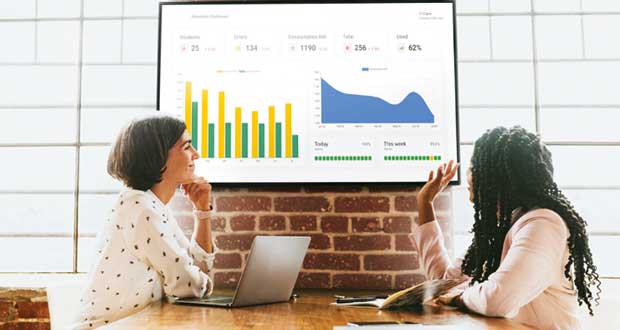Clara Mathey, Head of Marketing at Comeen explores how meeting room management and digital signage tools are reshaping modern facilities to connect people and optimise spaces
Managing hybrid work environments, optimising space utilisation, and fostering seamless communication are top priorities for FMs. This means that solutions that streamline operations and enhance collaboration are no longer optional, they’re essential.
To address these challenges, businesses must rethink traditional approaches. Meeting room management and digital signage are emerging as key tools to bridge gaps in communication and efficiency. From reducing wasted space to ensuring every employee feels informed and engaged, these innovations are transforming workplaces into connected, adaptable ecosystems.
ADDRESSING SPACE INEFFICIENCIES
Meeting rooms are a cornerstone of workplace collaboration, but inefficiencies in their usage can silently drain productivity and budgets. Ghost meetings, reserved spaces left unused and double bookings are frequent issues that waste resources, disrupt workflows, and frustrate employees. These challenges not only increase costs but also negatively impact employee retention and satisfaction.
To address these problems, smart room management solutions provide a game-changing approach. By offering real-time availability through dashboards or interactive maps, automated room releases for no-shows, and user-friendly booking interfaces, these tools eliminate common pain points. With real-time usage data, companies gain the insights needed to optimise space, ensuring every square foot is used effectively.
Advanced AI technologies further enhance the experience, enabling natural language booking and proactive notifications for conflicts or unused spaces.
The impact of such solutions is significant. Our research shows that organisations leveraging Comeen’s tools have recovered up to 35 per cent of underutilised space, while 50 per cent of released meetings (automatic or manual) are successfully rebooked. This optimisation maximises the value of existing resources while creating a frustration-free environment where employees can focus on collaboration rather than logistical challenges.
BRIDGING COMMUNICATION GAPS
Digital signage can facilitate workplace communication by bridging gaps and fostering transparency across teams. In office spaces, idle screens in meeting rooms and common areas become dynamic communication hubs. They provide real-time schedules, updates, safety protocols, and company announcements, ensuring employees remain informed without unnecessary distractions. Prominently displayed dashboards featuring business metrics or intranet news help align teams and enhance engagement.
For frontline workers without regular access to email or other digital tools, this technology is indispensable. Breakrooms and shared spaces transform into vital communication points, delivering real-time updates on business metrics, orders, or corporate news. AI-powered features such as auto-transcription and multilingual subtitles ensure inclusivity, making communication accessible for diverse teams. Urgent messages can also be delivered quickly and effectively, reducing delays and keeping everyone aligned.
Research highlights the significant impact of these tools. Studies show 84 per cent of employees find communication more accessible with visual tools like these, leading to higher engagement and reduced frustrations. This presents a clear opportunity to leverage visual communication strategies to foster community and alignment.
Beyond enhancing communication, these tools support corporate social responsibility (CSR) initiatives by cutting down on paper-based communication and allowing content to be scheduled at the desired time. Scheduling content during active hours and switching off displays during inactive times help cut waste and energy use, helping to meet sustainability goals.
This approach also builds transparency and inclusivity. Dynamic and concise communication ensures no one is left out, regardless of their role. Such strategies are key to boosting engagement and efficiency, enabling organisations to thrive in today’s interconnected workplace.
INTEGRATED APPROACHES FOR MODERN FACILITIES
Embedded solutions work seamlessly with existing workflows, such as Microsoft Teams and Google Workspace. This minimises the need for employees to learn new tools and ensures smoother adoption across teams, eliminating extra workload for facility, workspace, or IT managers as well as making implementation stress-free.
The benefits of integration extend far beyond operational efficiency. Organisations leveraging such solutions report significant improvements in resource utilisation, employee satisfaction and engagement.
Real-world implementations demonstrate the transformative impact of tailored solutions. By addressing diverse workplace needs, these systems empower employees to collaborate more effectively while simplifying decision-making for managers. By embracing cohesive approaches, facility managers can deliver results that go beyond cost savings, fostering environments where employees thrive, and organisations achieve their goals.
Meeting room management and digital signage are not standalone solutions; they complement each other to provide streamlined, efficient experiences for both employees and managers.





